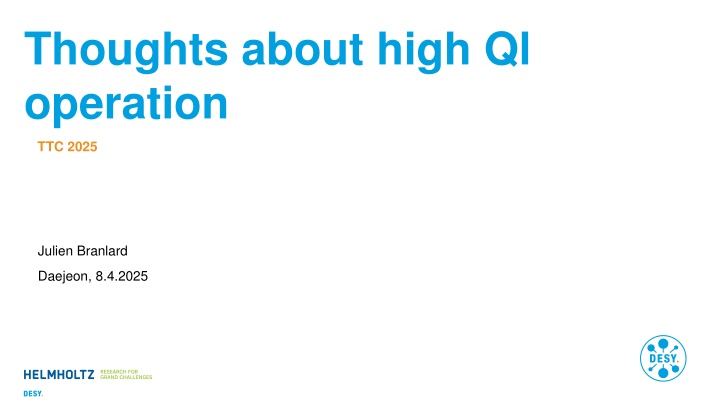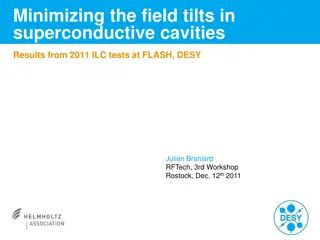
Efficiency Impact of Bandwidth and Resonance Control in High Ql Operation
Understanding the significance of bandwidth and resonance control in high Ql operation for efficiency improvements. Explore the challenges and motivations for operating at high Qext, aiming to enhance RF-to-beam efficiency while maintaining resonance control and system reliability in a demanding environment.
Download Presentation

Please find below an Image/Link to download the presentation.
The content on the website is provided AS IS for your information and personal use only. It may not be sold, licensed, or shared on other websites without obtaining consent from the author. If you encounter any issues during the download, it is possible that the publisher has removed the file from their server.
You are allowed to download the files provided on this website for personal or commercial use, subject to the condition that they are used lawfully. All files are the property of their respective owners.
The content on the website is provided AS IS for your information and personal use only. It may not be sold, licensed, or shared on other websites without obtaining consent from the author.
E N D
Presentation Transcript
Thoughts about high Ql operation TTC 2025 Julien Branlard Daejeon, 8.4.2025
Why is bandwidth and resonance control crucial for efficiency Bandwidth (Qext) and Resonance ( f) control Operating at higher Qext (narrower bandwidth) reduces the power needs IF resonance control can be guaranteed makes resonance control extremely challenging 4 kW Parameters for SRF gun 3.3 kW r/Q = 208 Ohm Vacc = 5 MV (energy gain from the gun at 50 MV/m -> 5 MeV) Ib = 100 uA (100 pC at 1 MHz) b = 0 deg. 2 kW 1.3 kW The challenge is to find the highest Qext one can operate the cavity at while still meeting the resonance control goals and without compromising operability and reliability of the system. 1 kW Qext = 4e7 Qext = 1e7 Page 2
Why operating at high Qext ? Motivation Improve RF-to-beam efficiency by reducing the input power needs It really pays off if resonance control works i.e. don t need a huge RF budget for resonance control piezo Courtesy A. Bellandi Page 3
Challenges at high Qext Microphonics control Ponderomotive drops / oscillations Pulsed operation (transients) High gradient (LFD) Courtesy A. Bellandi Page 4
Challenges at high Qext Ponderomotive drops Ponderomotive drops / oscillations Lorentz Force Detuning constant Cavity half- bandwidth Cavity voltage For TESLA cavities, ponderomotive drops start occuring when this ratio becomes smaller than -1.54 Courtesy A. Bellandi Page 5
Challenges at high Qext Ponderomotive drops Ponderomotive drops / oscillations Burst (now) 4,6 1,3 0 -0,9 25 -4,0 HDC (upgrade) 60 1,3 0 -0,9 20 -33,2 Qext f0 f1/2 Klfd Vcav KlfdVcav^2 / f/12 x10^6 GHz Hz Hz/MV^2 MV Courtesy A. Bellandi Page 6
Challenges at high Qext Vector sum operation IDEA: emulate SEL in pulsed operation during fill Rotate common RF phase drive Absorb Klfd differences using piezo Courtesy B. Richteri Page 7
Questions Qext At what Qext are the cavities set to ? (facilities / test stand) How is Qext set ? Is it remote controllable ? How much does it change with operation (thermal effect) ? Page 8
Questions Detuning What is the level of background microphonics ? Is there detuning control ? how ? Contribution slow tuner / fast tuners ? Page 9
Questions Who is using SEL to drive cavities ? at what gradient ? SELAP ? analogue / digital ? Visualization tools ? Cheeto Experience with operating high Qext cavities in pulsed mode ? in vector sum ? Experience with ponderomotive drop ? At what gradient / Qext Frequency of drops Recovery time ? How is it handled wrt. to beam operation Page 10
Discussion Cavity f0 TESLA 1.3 GHz TESLA 1.3 GHz Qext [x1e6] Voltage [MV/m] Klfd CW / pulsed Field Control Resonance control Facility [Hz/MV^2] EuXFEL (pulsed) EuXFEL (HDC) 4.6 23 -0.9 pulsed VS Piezo FB CW pulsed 6 18 -0.9 single Piezo FB Page 11
Quench movie Page 14


